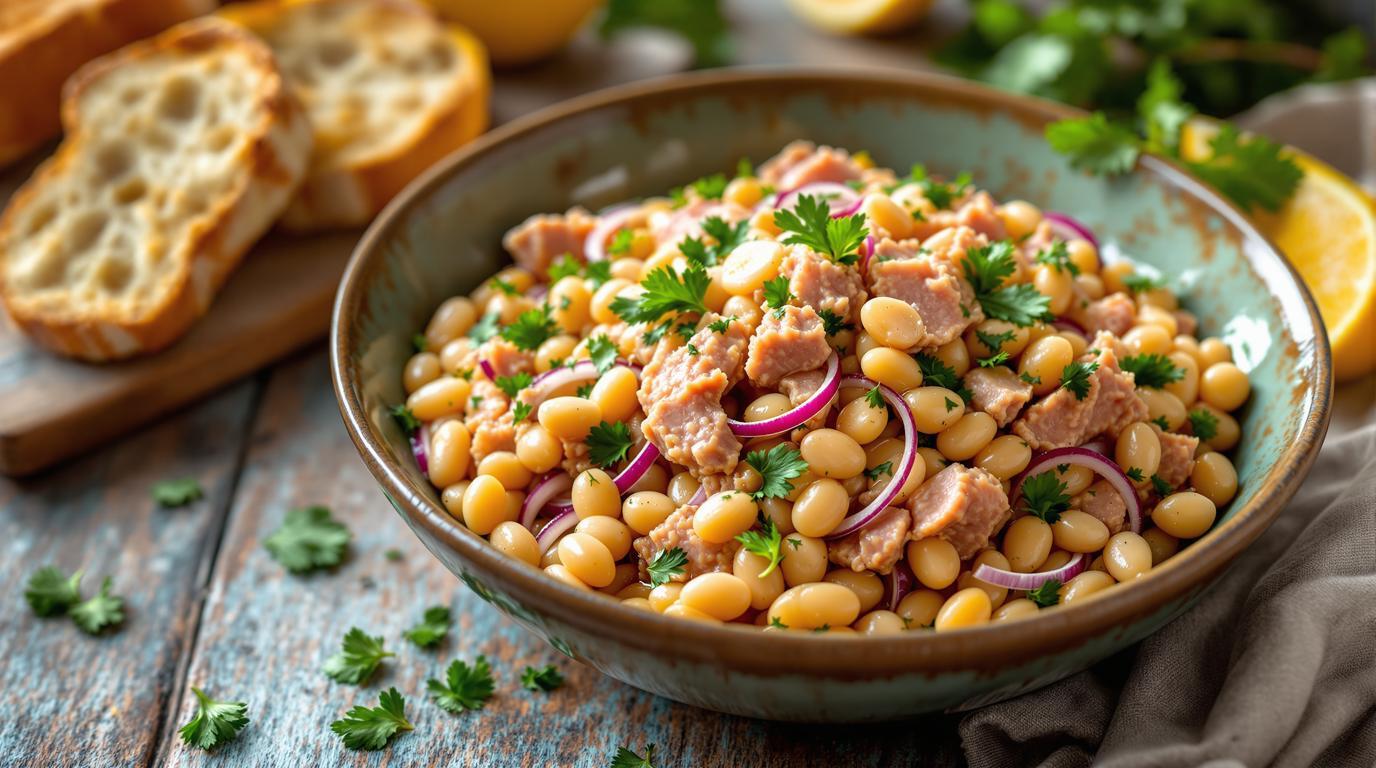There’s something profoundly comforting about Italian peasant cooking that speaks directly to the soul. Growing up, my nonna would often whip up a white bean and tuna salad when unexpected guests arrived or when summer heat made standing over a stove unthinkable. This dish—known as “Fagioli e Tonno” in Italy—embodies everything I love about Mediterranean cuisine: simplicity, nutrition, and stunning flavor from minimal ingredients. What most home cooks don’t realize is that this humble antipasto has sustained Italian families for generations, requiring nothing more than pantry staples and about five minutes of your time. 🇮🇹
The Story Behind White Bean & Tuna Salad 📖
This dish emerged from Italy’s “cucina povera” tradition—literally “poor kitchen”—where resourceful cooks transformed humble ingredients into nourishing meals. After World War II, when canned tuna became more widely available, this protein-packed combination gained popularity throughout the Italian peninsula. What began as a practical solution to hunger has endured as a beloved staple in Italian households, particularly in Tuscany where white beans are celebrated.
While traveling through small Italian villages years ago, I noticed each region had its own twist. Northern Italians kept it minimal and creamy, while southern regions added briny olives or sweet cherry tomatoes. What remained consistent was its role as a quick, nutritious meal that required no cooking—perfect for the Mediterranean summer heat. 🌞
Essential Ingredients 🧾
The magic of this dish lies in quality ingredients:
- 1 large can (15 oz/425g) cannellini beans, drained and rinsed
- 1 can (5 oz/142g) tuna in olive oil (never water!), drained but reserve 1 tablespoon oil
- ½ medium red onion, very thinly sliced (about ⅓ cup)
- ¼ cup fresh parsley, roughly chopped
- Juice of ½ lemon (about 1½ tablespoons)
- 3 tablespoons extra virgin olive oil (plus reserved tuna oil)
- Sea salt and freshly cracked black pepper to taste
For an elevated version, consider adding a handful of halved cherry tomatoes or 2 tablespoons of rinsed capers. Both additions honor regional Italian variations while adding brightness and complexity.
Step-by-Step Instructions 📝
This salad comes together effortlessly:
- Thoroughly rinse cannellini beans in a colander until water runs clear. This removes excess starch and sodium. Let drain completely.
- Gently flake tuna with a fork in a medium bowl, maintaining some texture—avoid mashing it completely.
- Add drained beans to the tuna. The key is handling them delicately to prevent breaking.
- Fold in the red onion slices and chopped parsley.
- In a small bowl, whisk together lemon juice, olive oil, reserved tuna oil, salt, and pepper to create a quick emulsified dressing.
- Pour dressing over the salad and gently toss until evenly coated.
- Allow to rest for 15 minutes before serving to let flavors meld.
Chef’s Secret Techniques 🤫
Chef’s Note: The quality of your tuna makes or breaks this dish. Look for Italian or Spanish tuna packed in olive oil—never water. The difference in flavor and texture is remarkable and worth the extra few dollars. The oil from the tuna contains tremendous flavor, which is why we reserve a tablespoon to incorporate into our dressing.
Temperature matters significantly here. While many serve this salad cold from the refrigerator, I’ve found that allowing it to come to just slightly below room temperature (about 20 minutes on the counter) dramatically enhances the flavors, much like a good beef braise tastes better the next day.
For the onions, soaking sliced red onion in cold water for 10 minutes before adding to the salad tames its sharpness while maintaining its crisp texture—a technique I learned while working in Sicily. 🌊
Serving & Presentation Tips 🍽️
In Italy, this salad is served at room temperature as part of an antipasto spread or as a light lunch. For a complete meal, I recommend serving it on a bed of arugula with crusty bread for scooping. A glass of chilled Vermentino or Pinot Grigio makes this simple meal feel like you’re dining on the Italian coast.
If you’re short on time in the morning, this salad makes an exceptional protein-rich breakfast alternative that keeps you satisfied for hours. For meal prep, make a double batch and portion into containers—the flavors only improve overnight.
For dinner guests, serve in a shallow white bowl, garnished with lemon wedges and additional fresh herbs. The contrast of creamy beans, flaky tuna, and bright herbs creates an effortlessly elegant presentation that belies the dish’s humble origins.
I’ve prepared this salad in professional kitchens and at countless family gatherings, yet its simplicity and honest flavors never fail to transport me back to those warm Italian afternoons with my nonna. Sometimes the most memorable dishes aren’t about complicated techniques, but rather about honoring quality ingredients with respectful handling. Like Cornell’s famous marinade, this recipe proves that culinary magic often lies in simplicity. Buon appetito! 🍷
